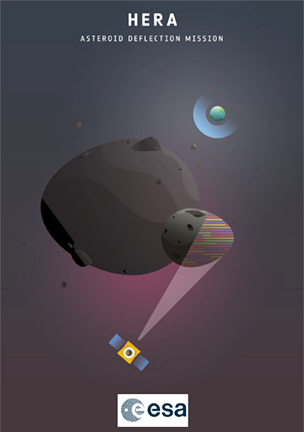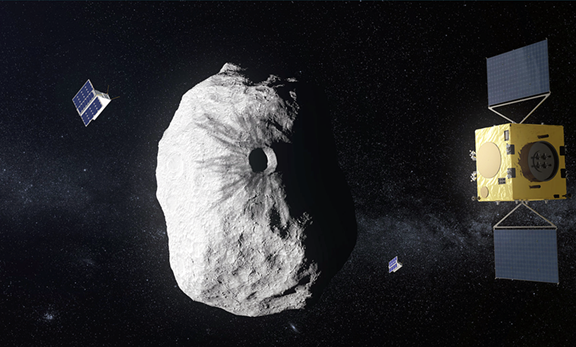

The continued development of the Juventas Cubesat is the focus of an addendum to the contract between GomSpace A/S and the European Space Agency (ESA) for the Asteroid Impact and Deflection Assessment (AIDA) mission, although final approval for this mission has not yet been approved by Europe's space ministers as of this writing. That is expected to occur during ESA's Space19+ meeting this month.
The total value of this contract to be shared among several partners is 1,165,000 euros, with the focus being the development of smallsat payloads in support of ESA's Hera mission, which itself is part of the AIDA and NASA DART missions. The GomSpace share of the funding is 295,000 euros.
Travel to the Didymos binary asteroid system is the goal. Juventas is a 6U cubesat that contains a low frequency radar as the primary payload and the smallsat will operate in close proximity to the Didymos asteroid system to perform radar and radio-science experiments that target the moon of the binary asteroid, nicknamed Didymoon.

Artistic rendition of Hera at Didymos. Image is courtesy of ESA.
The mission will be completed when the smallsat attempts to land on the surface of Didymoon to take measurements on the landing dynamics to capture details of the asteroid's surface properties.
The mission will end with measurements taken by a gravimeter payload to give insight into the dynamical properties of the asteroid.
GomSpace is the project lead with the science team, including collaborators from the Royal Observatory of Belgium and the University of Grenoble Alpes. The project continues its collaboration with:
- GMV Innovating Solutions from Romania leading the guidance, navigation and control subsystem
- Brno University of Technology from the Czech Republic contributing to the radar digital design
- Astronika from Poland delivering the radar antenna.

Niels Buus
This addendum adds new partners to the Juventas team, including EmTroniX from Luxembourg who will deliver the radar electronics and GomSpace Luxembourg who will contribute to the mission operations and AIV activities.
Niels Buus, CEO of GomSpace, said Juventas will be the first GomSpace designed nanosatellite in deep space demonstrating its capabilities in the most harsh of environments to date.

For all involved in the satellite and space industry and the various market segments that enhance these dynamic environments, the 2020 SmallSat Symposium is invaluable.
The 2020 SmallSat Symposium begins on February 3, 2020, with workshops on the first day. Then the Conference continues from February 4 to 6 at the Computer History Museum in Mountain View, California, in the heart of Silicon Valley.

The SmallSat Symposium is hosted by Satnews Publishers which, since 1983, has been a provider of satellite news, media and events. This information packed forum enables you and your company to secure a larger portion of market share as well as to take a step into the next stage of your company's, or organization's, growth.
The personal connections at the SmallSat Symposium enable attendees to network with established organizations, subject-matter experts as well as 'New Space' entrants.
The SmallSat Symposium will focus on the daily changes in new technologies and the business environment that is shaping the implementation of SmallSat constellations, SmallSat launchers, the challenges facing the SmallSat developer and actors as well as the enormous benefits of these advanced technologies that will benefit our world.
This event attracts more than 100 diverse speakers, all of whom possess deep industry experience. Additionally, numerous opportunities exist to mingle and network with peers while enjoying exceptional, complimentary meals and refreshment breakfast.

